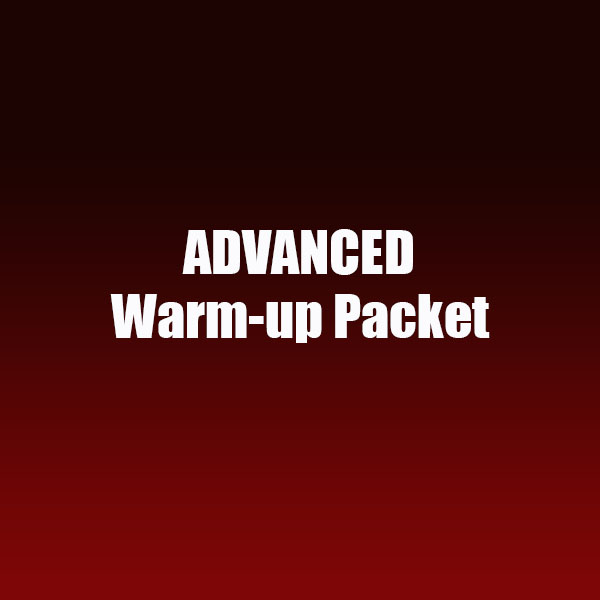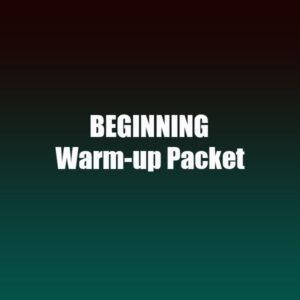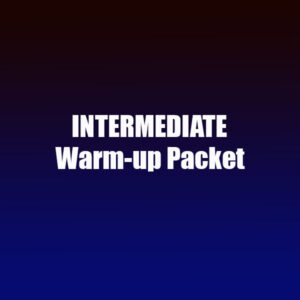Description
1. U 8 My 8s (adv)
This is a “stretch out the wrists” exercise consisting of patterns of 8 measures of 8th notes, that is usually played at the beginning of a warm up session.
Pit – This is a 2 mallet octave and 4-mallet warm up that utilizes the diatonic major scale, changing notes on the half note, then the quarter note, then the 8th note.. It should be used to stretch out the wrists and establish technique and listening at the beginning of a rehearsal. The accessory part is written on a conga drum, but can be played on a tom-tom, timbale, or even a drum pad.
Battery – This is a basic “8-on-a-hand” exercise that features a “8-7-6-5-4-3-1-4-5-6-7-8” sticking pattern for the snares and tenors, starting with both the right and left hands. It then reverts to a “1-3-4-5-6-7-8-8-7-6-5-4” sticking pattern, also starting with both hands. The bass drum part begins with a split 8th note pattern, that turns to 16th notes and then 16th note triplets. It then uses combinations of both until ending with 32nd notes. The cymbal part is written as “hi-hats”, but could be played with a variety of different sound techniques.
2. In The Zone (Bonus Warm Up)
This is a 16th note listening exercise to establish an ensemble sound. It is usually the first “hands together” exercise of the warm up sequence.
Pit – This is a 2-mallet exercise to practice getting an even sound and balance from all players. It goes through a series of familiar children’s songs before ending with a “5 over 4” pattern on a familiar tune.
Battery – This is a 16th note accent/tap exercise that is designed to practice controlling the taps after the accents and building a strong ensemble sound.
(Not available for individual purchase)
3. Cold Cut Combo Deluxe
This is a combination double beat / 4 mallet blues exercise.
Pit – The chords in the C7 Blues progression are rhythmically syncopated to line up with the battery rhythms, but could also be played to a ‘click’ or even a stick click. It has a 2-handed octave vibraphone part and a more difficult 4-mallet marimba part.
Battery – This is a double beat warm up to get the hands ready to play some open rolls. The first 8 bars should be played “all up”, while the last 8 bars should utilize a “2-height” accent/tap approach.
4. Checkers
This is a major scale / roll warm up.
Pit – This is a simple diatonic major scale 16th note exercise that can be played with a “right hand lead” or a “left hand lead”. Alternating between both would be ideal. The vibraphone part offers an easier 8th note pattern for less experienced players. The accessory percussion part provides a rhythmic foundation with a conga / tambourine part that provides both time and a fun groove to play along to with .
Battery – This is an open roll exercise that utilizes “high”, “low” and crescendo rolls. The first bar should be played “up”, while the 2nd bar should be played with an “accent/tap” approach to the heights. The rolls in the 3rd and 4th bars should be crescendos, but not overplayed at the top.
5. Celtics (adv)
This exercise began as a tribute to the classic exercise “Boston”, hence the title. It serves as a minor chord exercise and an accent / tap / roll / diddle exercise in 12/8.
Pit – This exercise follows a C minor scale and utilizes both 2 and 4-mallet parts. The vibraphone part works the minor arpeggios in a 2 mallet “up-down” mode, while the marimba part is designed to work on 4-mallet independence, utilizing an “inner, inner, outer, outer” pattern. The accessory percussion part provides a rhythmic foundation with a conga / tumba part that provides both time and a fun groove to play along to.
Battery – This is a tap roll exercise that also works syncopation and listening. There are no flams in this exercise to allow for extreme tempo adjustments as necessary. (Reef it!)
6. 11 Single 7
This is an advanced level 11 measure single exercise in 7/8.
Pit – This exercise features a chromatic 16th note triplet pattern in the marimba, which works leading with either hand. The vibraphone is a 2-mallet part that plays along with the bass guitar and adds some tri-tone tension to the mix. The piano works on timing in 7/8 while the accessory part doubles the marimba.
Battery – This exercise works singles in groupings of 6 and 4 (mimicking a 4-stroke ruff pattern), leading with both right and left hands. The length of the single stroke rolls increases as the exercise progresses, culminating with a single stroke 5-stroke 32nd note roll. Good times.
7. BMT (Big Meaty Tasty) (adv)
This warm up continues my “Subway Sandwich” theme, and is an advanced arpeggio / flam exercise.
Pit – This exercise is for practicing arpeggios in a chromatic scale. The vibraphone part works the arpeggios in a 2 mallet “up-down” mode, while the marimba part is designed to work on 4-mallet independence, utilizing an “inner, inner, outer, outer” pattern. The timpani, accessory, and left hand piano parts work together to provide an interesting rhythmic support to the keyboard 8th notes while supporting the battery rhythms.
Battery – This exercise is designed to be an advanced flam warm up that utilizes flam accents, flam drags, flam stutters (cheeses), inverted flam taps (“inverts”), flam 5’s, paradiddles, paradiddle-diddles, triplet rolls, single stroke rolls, and triple stroke rolls (3’s). Special care should be taken during bars 11 and 12 to maintain the integrity of the 16th note triplets and try to maintain a consistent sound thru out the sticking changes.
8. BTM (Beat The Meat)
This is what we call a “Hero Warm up”. It is a “shopping spree” type jam in 5/8 that throws everything in the basket but the kitchen sink.
Pit – This exercise follows a chromatic scale and utilizes both 2 and 4-mallet parts. The vibraphone part works in thirds, going up the chromatic scale, while the marimba part is designed to work on 4-mallet independence, utilizing an “inner, inner, outer, outer” pattern. The accessory part is written on a conga drum, but can be played on a tom-tom, timbale, or even a drum pad.
Battery – This is a variation on a flam accent “shopping spree” that utilizes singles, threes, back-beat swiss triplets, flam taps, pataflaflas, inverts, diddles and rolls. It is a lot of fun to play!


